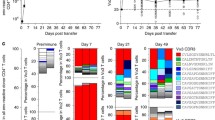Abstract
Previous experiments with cloning of immunocompetent cells indicate a switch from IgM to IgG during the multiplication of immunologically activated cells derived by proliferation from one precursor. An alternative explanation, cooperation of one T cell with two different B cells (IgM and IgG precursors) is experimentally studied in the present work. Control experiments indicate that all detected foci are dependent on the production of antibodies and the action of complement. Numbers of foci are linearly dependent on the quantity of cells transferred to isologous lethally irradiated mice. There is a time gap between the first detection of antibodies by the focus technique (on the 4th day after the transfer) and by the plaque technique with isolated cells (detectable only from the 6th day after the transfer); early foci contain antibodies but do not produce (secrete) them in sufficient amounts. Transfer of lymphocytes isolated from spleen, bone marrow and thymus showed that foci in the primary response are formed only by B lymphocytes. The transfer of a constant number of B lymphocytes with increased numbers of T lymphocytes did not change the quantity of Ab-forming foci; there is an increase, however, of the numbers of individual cells producing antibodies detected by the plaque technique,i.e. the number of Ab forming cells per individual clone (focus). Through the action of T lymphocytes the switch from IgM to IgG is made possible. The auxiliary role of T lymphocytes in the primary response is discussed.
Similar content being viewed by others
References
Armstrong W. D., Diener E.: A new method for the enumeration of antigen-reactive cells responsive to a purified protein antigen.J. Exptl. Med. 129, 371 (1969).
Bernovská J., Kostka J., Šterzl J.: Haemolytic reaction in gels.Folia Microbiol. 8, 376 (1963).
Campbell P. A.: T cells: the limiting cells in the initiation of immune responses in normal mouse spleens.Cell. Immunol. 5, 338 (1972).
Cebra J. J., Colberg J. E., Dray S.: Rabbit lymphoid cells differentiated with respect to α-, γ- and μ-heavy polypeptide chains and to allotypic markers Aa1 and Aa2.J. Exptl. Med. 123, 547 (1966).
Cunningham A. J.: The development of clones of antibody-forming cells in the spleens of irradiated mice. I. Detection of plaque-forming cell colonies, and their relationship to haemolytic foci.Austr. J. Exp. Biol. Med. Sci. 47, 485 (1969).
Feldman M., Basten A.: The relationship between antigenic structure and requirement for thymus derived cells in the immune response.J. Exptl. Med. 134, 103 (1971).
Hartmann K. U.: Induction of hemolysin response in vitro. II. Influence of the thymus-derived cells during the development of the antibody-producing cells.J. Exptl. Med. 133, 1325 (1971).
Katz D. H., Paul W. E., Goidl E. A., Benacerraf B.: Carrier function in anti-hapten immune responses. I. Enhancement of primary and secondary anti-hapten antibody responses by carrier preimmunization.J. Exptl. Immunol. 132, 261 (1970).
Kennedy J. C., Siminovitch L., Till J. E., McCulloch E. A.: A transplantation assay for mouse cells responsive to antigenic stimulation by sheep erythrocytes.Proc. Soc. Exptl. Biol. Med. 120, 868 (1965).
Lawrence H. S., Landy M.: Mediators of Cellular Immunity. Academic Press, New York 1969.
Mäkelä, O.: The specificity of antibodies produced by single cells.Cold Spring Harbor Symp. Quant. Biol. 32, 432 (1967).
Mäkelä, O.: In:Cell Interactions and Receptor Antibodies in Immune Responses. Academic Press, New York 1971, p. 229.
Miller J. F. A. P., Basten A., Sprent J., Cheers C.: Interaction between lymphocytes in immune responses.Cell. Immunol. 2, 468 (1971).
Mitchell G. F., Humphrey J. H., Hamilton J. A.: Influence of T cells on IgM and IgG antibody production in mice. In:Proc. Int. Symp. The Spleen, its Pathophysiology. (1973).
North J. R., Feinstein A.: Analysis of anti-hapten foci in repopulated mouse spleens.Europ. J. Immunol. 3, 783 (1973).
Pernis B., Chiappino G., Kelus A. S., Gell P. G. H.: Cellular localization of immunoglobulins with different allotypic specificites in rabbit lymphoid tissues.J. Exptl. Med. 122, 853 (1965).
Playfair J. H. L., Papermaster B. W., Cole L. J.: Focal antibody production by transferred spleen cells in irradiated mice.Science 149, 998 (1965).
Playfair J. H. L., Purves E. C.: Antibody formation by bone marrow cells in irradiated mice. I. Thymus-dependent and thymus-independent responses to sheep erythrocytes.Immunology 21, 113 (1971).
Raff M. C., Owen J. J. T.: Thymus derived lymphocytes: their distribution and role in the development of peripheral lymphoid tissues of the mouse.Eur. J. Immunol. 1, 27 (1971).
Roelants G.: Antigen recognition by B and T lymphocytes. In:Current Topics in Microbiology and Immunology, vol. 59, Springer Verlag, Berlin 1972, p. 135.
Sela M., Mozes E., Shearer G. M.: Thymus-independence of slowly metabolized immunogens.Proc. Nat. Acad. Sci. USA 69, 2696 (1972).
Schirrmacher V., Rajewsky K.: Determination of antibody class in a system of cooperation antigenic determinants.J. Exptl. Med. 132, 1019 (1970).
Schmidtke J. R., Dixon F. J.: Immune response to a hapten coupled to a nonimmunogenic carrier.J. Exptl. Med. 136, 392 (1972).
Šterzl J., Mandel L.: Estimation of the inductive phase of antibody formation by plaque technique.Folia Microbiol. 9, 173 (1964).
Šterzl J., Říha I.: Detection of cells producing 7S antibodies by the plaque technique.Nature 208, 858 (1965).
Šterzl J., Nordin A.: Demonstration of the common precursor for production of IgM and IgG antibodies.Folia Microbiol 16, 1 (1971a).
Šterzl J., Nordin A.: The common cell precursor for cell producing different immunoglobulins. In:Cell Interactions and Receptor Antibodies, Mäkelä O. (Ed), Academic Press, New York 1971b.
Šterzl J., Tlaskalová H.: The cooperation of lymphoid cells during the induction of the immune response.Folia Microbiol. 16, 529, 1971.
Vann D. C., Cambell P. A.: Plaque-forming cells of two different origins in single hemolytic foci.J. Immunol. 105, 1584 (1970).
Author information
Authors and Affiliations
Additional information
Dedicated to Prof. F. Patočka on his 70th birthday
Rights and permissions
About this article
Cite this article
Šterzl, J. The role of B and T lymphocytes in forming cell clones producing antibodies. Folia Microbiol 19, 349–357 (1974). https://doi.org/10.1007/BF02872818
Received:
Issue Date:
DOI: https://doi.org/10.1007/BF02872818




